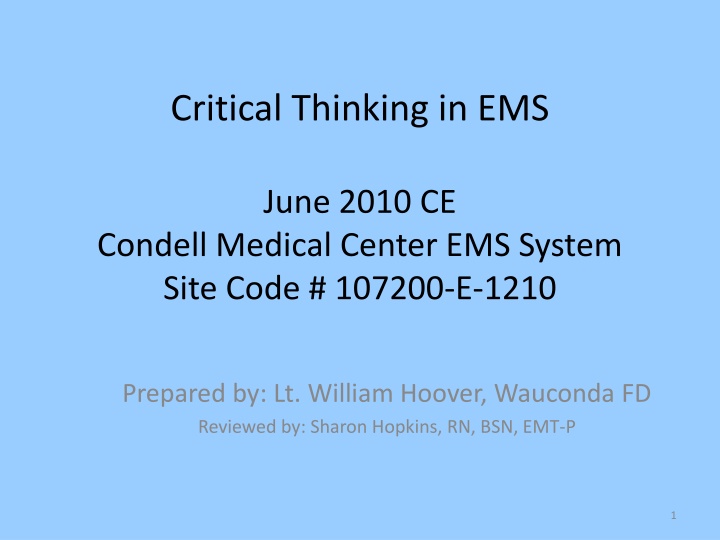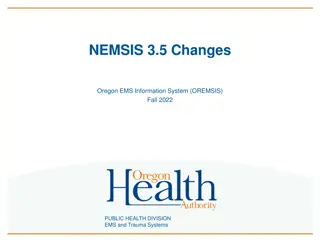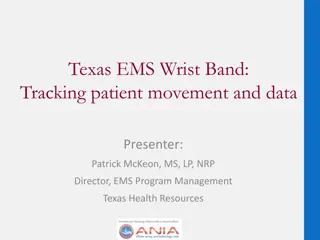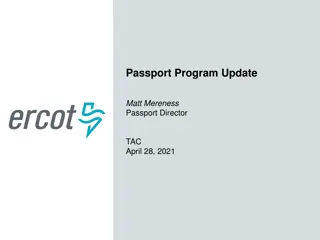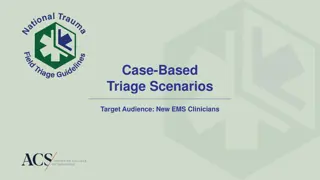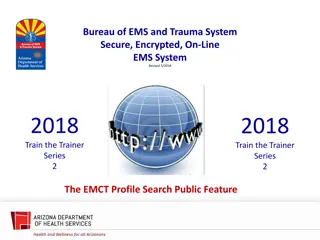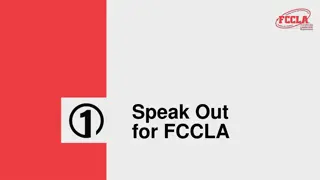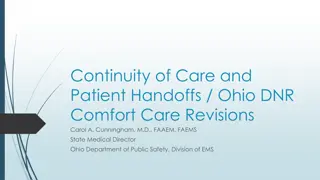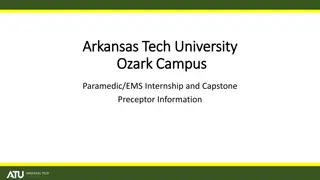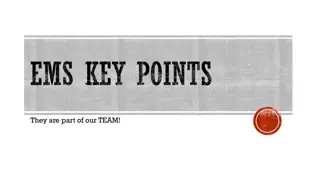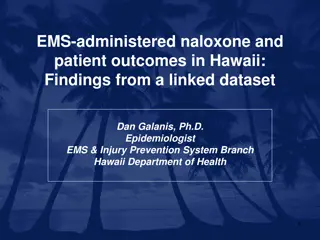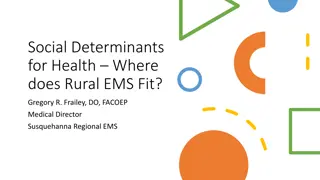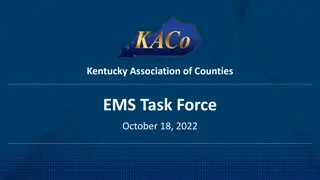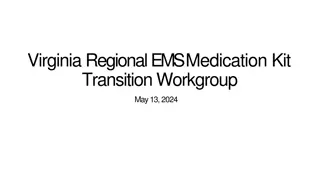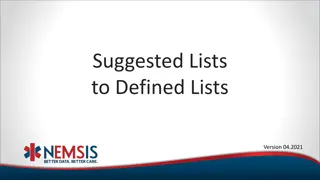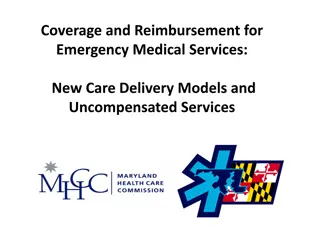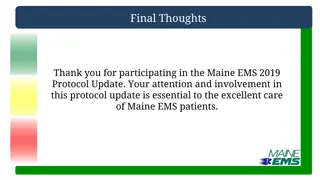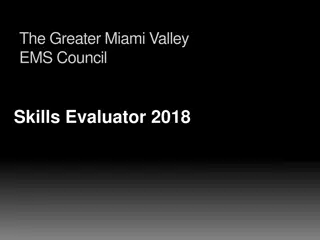Enhancing Critical Thinking Skills in EMS: A Comprehensive Guide
Explore the importance of critical thinking in Emergency Medical Services (EMS) through identifying patient care influenced by biased decision-making, communication issues, transportation options, and more. Delve into real-life lawsuits impacting EMS providers and the role of Standard Operating Procedures (SOPs) in patient care scenarios.
Download Presentation

Please find below an Image/Link to download the presentation.
The content on the website is provided AS IS for your information and personal use only. It may not be sold, licensed, or shared on other websites without obtaining consent from the author.If you encounter any issues during the download, it is possible that the publisher has removed the file from their server.
You are allowed to download the files provided on this website for personal or commercial use, subject to the condition that they are used lawfully. All files are the property of their respective owners.
The content on the website is provided AS IS for your information and personal use only. It may not be sold, licensed, or shared on other websites without obtaining consent from the author.
E N D
Presentation Transcript
Critical Thinking in EMS June 2010 CE Condell Medical Center EMS System Site Code # 107200-E-1210 Prepared by: Lt. William Hoover, Wauconda FD Reviewed by: Sharon Hopkins, RN, BSN, EMT-P 1
Objectives Upon successful completion of this module, the EMS provider will be able to: Identify the need for critical thinking in Emergency Medicine Identify patient care influenced by biased decision making Identify documentation influenced by biased decision making Identify critical thinking skills and their application to EMS 2
Objectives contd Identify communication issues that can lead to patient care errors Identify different levels of patient acuity Identify transportation options a patient may/may not have Identify use of differential diagnosis to provide improved patient care 3
Objectives contd Discuss, as a member of a group, factors involving lawsuit Schulman v. County of Los Angeles Discuss, as a member of a group, factors involving lawsuit Hackman v. American Medical Response Discuss, as a member of a group, factors involving lawsuit Wright v. City of Los Angeles 4
Critical Thinking in EMS There is a need for field based EMS personnel to think outside the box . A number of lawsuits initiated due to inaccurate care of a patient. Determine best way to provide quality care. SOP s cannot cover every scenario we may face in the field Decision making is expected of us! 5
Critical Thinking in EMS We must obtain medical information for each individual patient. Then we have to decide what we think is going wrong with our patient. After that we come up with a plan for treatment. Then we evaluate the treatment; make modifications as needed. Simple, right??? 6
SOPs They are only one tool in our toolbox Each patient is different & needs to have their own treatment plan. SOP s should not be our first option, rather they should be our safety net. We should use our paramedic training to figure out what is wrong with our patient & how we are going to fix it as our first option. 7
SOPs What if our plan is not covered under the SOP s? Medical control! Medical Control should be our second option for making the decision. 8
Example Patient info: 45 year old male, difficulty breathing 124/78, P-90, R-28, SPO2-96%, Temp- 1010 F Productive cough Diagnosis? Probably pneumonia? What if patient breathing gets worse? Would you give him oxygen? Would you want to put him on CPAP? Nebulizer treatment? 9
Making the right choice- Oxygen is a given for any breathing issues, so there is no issue placing them on a NRB mask Have we ever been taught to use CPAP on a pneumonia patient not really So, we contact Medical Control, give report and ask if we can use CPAP with this patient. If Medical Control gives permission, then we are good to go If we can t reach Medical Control, we revert to our SOP s There is no SOP for Pneumonia, so we would not be allowed to use CPAP without an order 10
BREAK OUT SESSION Break up into groups and review case #1 Details in handout Have one member take notes and be prepared to present your answers to the following: What is wrong with the patient? What treatment plan would you have? How would you give report to hospital? Which SOP would cover this patient? 11
Case #1 -Schulman v. County of Los Angeles 22 y/o female student had 1 alcoholic beverage with dinner and returned home 2100 2210 out again (Karaoke bar) and had 1 beer 2230 sang a song and soon after had symptoms: Excruciatingly sharp pain near left ear Dizziness getting worse Began to stumble Became acutely disoriented Holding head in pain Began vomiting Speech now unintelligible Patient collapsed 12
Case #1 - Biased Decision Making The patient in case review #1 suffered from a cerebral hemorrhage. A three hour delay in diagnosis in the ED due to the biased decision making by the paramedics Schulman v. County of Los Angeles Fire Department (February 7, 2006). Note: Full details of case in handout 13
Biased Decision Making It is important to evaluate each patient based on the individual call, not prior calls. Has anyone had a chronic caller ? After awhile, did the care provided decrease in quality? This is the call where we cringe when the tones go out. We all recognize the address. This is also the call that we get into trouble with when the patient has a legitimate problem and we miss it due to sloppy medicine & biased thoughts. 14
Biased documentation Think about what you write! Imagine sitting on the witness stand explaining to the court what PITA stands for! If you are called for a patient with chest pain and don t treat the patient s chest pain, have you really done your job? Can you treat a patient following two different protocols? 15
Minimizing Bias in Assessment Most errors in EMS are caused by slipshod assessments. Short cuts on vitals Incomplete assessment Not obtaining all of the medical history Incomplete medication review (what are the meds for?) Not fully exposing patient 16
Minimizing Bias in Assessment Remove biased feelings and treat all patients the same. After 9/11 did Muslim patients receive the same quality of care? Does a minority on welfare get treated the same as the local elected official? Simply be nice to everyone! 17
Its not all your fault!!! EMS has focused on SOP training, memorization of algorithms and refresher education. What good is a mnemonic if everyone remembers the letters, but not what they stand for? It is your responsibility to learn a few new EMS items on your own. 18
Learning Critical Thinking Skills Think independently Police arrive at MVC with a drunk But, this patient looks pale. Most drunks you ve seen have a flushed face. Patient glucose, when checked, was 19. Be open-minded! Not everything is as it seems. Be courageous Be an advocate for your patient Stand up for what is right 19
Learning Critical Thinking Skills Study mistakes of others Review good calls of others Critique your calls, documentation and performance Did you provide the best treatment to your patient? Could you have improved your performance on the call? What could you do different? 20
Communication Issues Tenerife airport disaster The collision took place on March 27, 1977, at 17:06:56 local time. The aircraft were operating as Pan Am Flight and KLM Flight 4805. Taking off in heavy fog on the airport's only runway, the KLM flight crashed into the top of the Pan Am aircraft back taxiing in the opposite direction. The Pan Am had followed the back taxiing of the KLM aircraft, under the direction of Air Traffic Control, and the KLM's flight crew had been aware of Pan Am back taxiing behind them on the same runway. Despite lack of visual confirmation (because of the fog) the KLM captain thought that Pan Am had cleared the runway and so attempted to take off without further clearance to do so. 21
Communications Issues Immediately after lining up, the KLM captain advanced the throttles (a standard procedure known as "spin-up", to verify that the engines are operating properly for takeoff) and the co-pilot , surprised by the maneuver, quickly advised the captain that clearance had not yet been given. The Captain responded, "I know that. Go ahead, ask. . The co-pilot then radioed the tower that they were "ready for takeoff" and "waiting for our clearance". The KLM crew then received a clearance which specified the route that the aircraft was to follow after takeoff. The instructions used the word "takeoff", but did not include an explicit statement that they were cleared for takeoff. 22
Communications Issues The co-pilot read the flight clearance back to the controller, completing the read back with the statement "we're now at takeoff" or "we're now, uh, taking off" (the exact wording of his statement was not clear, indicating to the controller that they were beginning their takeoff roll). The Captain interrupted the co-pilot's read back with the comment "We're going 23
Communications Issues The Spanish controller, who could not see the runway due to the fog, initially responded with "OK" (terminology which is nonstandard), which reinforced the KLM captain's misinterpretation that they had takeoff clearance. The controller's response of "OK" to the co-pilot's nonstandard statement that they were "now at takeoff" was likely due to his misinterpretation that they were in takeoff position and ready to begin the roll when takeoff clearance was received, but not actually in the process of taking off. The controller then immediately added "Stand by for takeoff, I will call you", indicating that he had not intended the clearance to be interpreted as a takeoff clearance. He probably had not heard the captain's announcement that they were "going", since the captain had said this to his fellow crew members and not transmitted it on the radio himself. 24
Communications Issues However, a simultaneous radio call from the Pan Am crew caused mutual interference on the radio frequency, which was audible in the KLM cockpit as a whistling sound. This made the crucial latter portion of the tower's response audible only with difficulty by the KLM crew. The Pan Am crew's transmission, which was also critical, was reporting that "We're still taxiing down the runway!" This message was also blocked by the interference and inaudible to the KLM crew. Either message, if heard in the KLM cockpit, would have given the KLM crew time to abort its second takeoff attempt. 25
Miscommunication in EMS? Communication between ECRN & Paramedics Did we paint a good picture of what we have? If the ECRN is asking a lot of questions, probably not. ECRN unfamiliar with field conditions? EMS unable to obtain IV, ET, etc. Directions that you don t feel are right? What should you do? Should you just follow orders anyway? 26
Miscommunication With Dispatch Dispatched to a Full Code at local nursing home Ambulance rolls with engine as back up for additional personnel for the Full Arrest Full Code to the nursing home was an internal terminology meaning the patient had no DNR 27
Blah, blah, blah You are dispatched to a call for a 53 year-old female with abdominal pain Your focus would naturally be thinking of a problem in the abdomen, but as we know it could be a cardiac event Keep an open mind! 28
Patient Acuity Levels Life threatening Critical; red; arrested; imminently arresting; needs immediate intervention Potentially life threatening Relatively stable but could worsen; yellow; need careful monitoring for changes Non-life threatening Stable; green; care at BLS level 29
Life Threatening These are the calls where we need to use our brains. THINK! What can you do to stabilize the patient? Accelerated transport means thinking fast and moving fast Presents challenges with ALS skills while moving Is there something you could do outside of SOP s that you can/need to request Medical Control? 30
Potential Life Threatening These are the patients we are relieved they still have a pulse when we arrive at ED We need to recognize this patient and be proactive in our treatment Stay one step ahead of the problem Assess, assess, assess And reassess often to note deterioration Did we say reassess? 31
Non-life Threatening Obviously a slower pace and the ability to ask more questions Generally we have the time to be more of a detective at the home Where does patient get their meds from? Patient given steroids by one doctor for breathing issues. Prescription filled at pharmacy A . Patient given steroids by second doctor for shoulder injury. Prescription filled at pharmacy B . Patient did not feel well. Wonder why??? 32
BREAK OUT SESSION Get back with your groups and review Case #2 Have one member take notes and be prepared to present your answers to the following: How would your group handle a call like this? Does the bystander statements give us cause to be concerned about the patient? Would this case be different if the paramedics had done a full work up on the patient? 33
Case #2 Hackman v. American Medical Response A female struck a parked car in a residential area Air bag deployed Bystanders report patient was dazed , confused , unstable , speech slurred , wobbled , and swayed like she was drunk Ems found patient standing next to vehicle talking with police Ems conducted a visual and interactive assessment 34
Case #2 contd EMS assessed: Breathing Verbal responsiveness Eyes Ability to move extremities Skin color Asked questions regarding alcohol consumption EMS concluded patient not injured Patient stated she was fine and refused transport 20 minutes after EMS left, patient collapsed Bystanders report speech slower, slurred, walking around dumbfounded EMS returned and transported patient 35
Case #2 contd EMS contends that if they felt patient needed treatment, then they would have filled out a form for patient to sign AMA and strongly encouraged treatment & transport Hackman v. American Medical Response; April 16, 2004 Patient alleges negligence by leaving her at the scene after 1st visit Judgment reverse: Plaintiff entitled to costs Note: Full details of case in handout 36
Transportation Options Trauma patient Transport to a Level 1: if transport inside of 25 minutes Condell Medical Center, Libertyville Lutheran General, Park Ridge Helicopter vs. ground transport Level 2 facility: Closest hospital Criteria is different regarding surgical interventions 37
Transportation Options Medical patient We don t have the options of bypassing one hospital to go to another (per IDPH rules & regs) Stroke Centers Cardiac cath labs Pediatric ED Use some common sense If hospital CT is out of service, request transport to next closest appropriate hospital for a patient experiencing a possible stroke 38
Transportation Options A patient can go to a hospital that is not the closest in life threatening, potential life threatening or non-life threatening situations Patient must be awake & oriented They must sign the call sheet/release stating their wish to go to a hospital further away Make sure they sign the paper before transporting. If they die during the transport, it s tough to get their signature then! 39
Signed Releases We cannot play Bonnie & Clyde and kidnap people. If they don t want to go, it s their right. This is an area where we get into trouble (remember Hackman v. AMR with no documentation?) Documentation is our best option to protect ourselves. Take the time to write down what the patient said! Fill out all boxes, signatures, etc. or Sharon will hunt you down! (Sharon reviews all releases) 40
Documentation of Releases Of all times to have detailed, careful documentation, these are the times May only have the documentation to rely on for recall of details Absolutely need a full set of vitals Even better are vitals at the time you leave the patient to demonstrate patient condition/stability Can always get respiratory rate, effort, skin conditions on patients that refuse vitals How do you get refuses vitals on a minor when waiting for parent arrival? Why weren t vitals already done? 41
Documenting Releases contd If there is a spot, fill it out!!! What is the patient refusing? Initial assessment (ie: vitals)? Further assessment? Treatment? Transportation? All three signatures present? Patient? Check whose signature is obtained Ambulance personnel? Witness? Date documented? Did you document instructions to the patient? 42
Trick Bag of Releases Did you need involvement of Medical Control? Did you document who you talked to? If patient is hypoglycemic, is the last documented blood sugar greater than 60? If you talked to the parents via phone for a minor, did you document the permission was via phone and get the parent s name? Must use authorized person to sign the release If the patient unable to sign, did you document verbal permission obtained from patient Not okay to have spouse, police, others sign for patient 43
Differential Diagnosis Requires close attention to all aspects of the assessment, signs & symptoms, complaints and diagnostic information. When dispatched, we should start forming a broad list of possible diagnosis of patient. Trouble breathing: Think COPD, Asthma, Pneumonia, etc Once we get on scene we should start eliminating possibilities 44
Differential Diagnosis For every chief complaint, form your list of possible causes 70 year-old calls 911 for difficulty breathing Has no past hx of asthma & takes no asthma meds Combine the most critical and most common causes for the complaint Use your diagnostic tools to either prove or disprove a cause. Move on to the next cause 45
List of R s React to life threats Read the scene and patient Respond to your findings Re-evaluate your treatment Revise as necessary Review your performance 46
Case Study 72 year-old with shortness of breath B/P: 134/62, P: 96, R: 30, SPO2: 94% room air Pale, cool, moist skin Hx of emphysema after 50 years of 2 pack a day smoking What are some possible causes of the breathing issues? What would you need to prove or disprove your theory? 47
Differential diagnosis When working through the possible causes, eliminate the most critical or life threatening first. Consider underlying causes that may be hidden Elderly patient who fell and broke leg Was it a cardiac event that caused the fall? Doesn t look good with a leg well splinted but patient suffers critical damage to the heart due to lack of diagnosis 48
Patient History A valuable tool in figuring out what is happening now, but not the end all Bar owner with history of abdominal problems and alcohol abuse calls for stomach pains No 12 lead was done because of the hx. Patient was having an MI and was eventually taken to cath lab with 100% occlusion noted in some arteries Don t fall into the history trap! 49
Zepeda v. City of Los Angeles Parents of shooting victim sued city for wrongful death alleging that a paramedic crew refused to render medical attention or otherwise assist victim until police arrived at the scene. Court found that the paramedics were not obligated to render assistance when scene was not secure. 50
